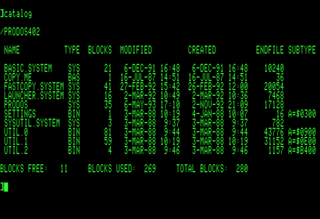Related Research Articles

The Apple II series of microcomputers was initially designed by Steve Wozniak, manufactured by Apple Computer, and launched in 1977 with the Apple II model that gave the series its name. It was followed by the Apple II Plus, Apple IIe, Apple IIc, and Apple IIc Plus, with the 1983 IIe being the most popular. The name is trademarked with square brackets as Apple ][, then, beginning with the IIe, as Apple //. In terms of ease of use, features, and expandability, the Apple II was a major advancement over its predecessor, the Apple I, a limited-production bare circuit board computer for electronics hobbyists.

The history of the graphical user interface, understood as the use of graphic icons and a pointing device to control a computer, covers a five-decade span of incremental refinements, built on some constant core principles. Several vendors have created their own windowing systems based on independent code, but with basic elements in common that define the WIMP "window, icon, menu and pointing device" paradigm.

Lotus 1-2-3 is a discontinued spreadsheet program from Lotus Software. It was the first killer application of the IBM PC, was hugely popular in the 1980s, and significantly contributed to the success of IBM PC-compatibles in the business market.

WordPerfect (WP) is a word processing application, now owned by Alludo, with a long history on multiple personal computer platforms. At the height of its popularity in the 1980s and early 1990s, it was the dominant player in the word processor market, displacing the prior market leader WordStar.

WordStar is a word processor application for microcomputers. It was published by MicroPro International and originally written for the CP/M-80 operating system, with later editions added for MS-DOS and other 16-bit PC OSes. Rob Barnaby was the sole author of the early versions of the program.

ProDOS is the name of two similar operating systems for the Apple II series of personal computers. The original ProDOS, renamed ProDOS 8 in version 1.2, is the last official operating system usable by all 8-bit Apple II series computers, and was distributed from 1983 to 1993. The other, ProDOS 16, was a stop-gap solution for the 16-bit Apple IIGS that was replaced by GS/OS within two years.
Apple DOS is the family of disk operating systems for the Apple II series of microcomputers from late 1978 through early 1983. It was superseded by ProDOS in 1983. Apple DOS has three major releases: DOS 3.1, DOS 3.2, and DOS 3.3; each one of these three releases was followed by a second, minor "bug-fix" release, but only in the case of Apple DOS 3.2 did that minor release receive its own version number, Apple DOS 3.2.1. The best-known and most-used version is Apple DOS 3.3 in the 1980 and 1983 releases. Prior to the release of Apple DOS 3.1, Apple users had to rely on audio cassette tapes for data storage and retrieval.

AppleWorks was an integrated office suite containing a word processor, database, and spreadsheet. It was developed by Rupert Lissner for Apple Computer, originally for the Apple II platform and launched in 1984. Many enhancements for AppleWorks were created, the most popular being the TimeOut series from Beagle Bros which extended the life of the Apple II version of AppleWorks. Appleworks was later reworked for the Macintosh platform.

Microsoft Works is a discontinued productivity software suite developed by Microsoft and sold from 1987 to 2009. Its core functionality includes a word processor, a spreadsheet and a database management system. Later versions have a calendar application and a dictionary while older releases include a terminal emulator. Works is available as a standalone program and as part of a namesake home productivity suite. Because of its low cost, companies frequently preinstalled Works on their low-cost machines. Works is smaller, less expensive, and has fewer features than contemporary major office suites such as Microsoft Office.

PC Tools is a collection of software utilities for DOS developed by Central Point Software.
Amiga software is computer software engineered to run on the Amiga personal computer. Amiga software covers many applications, including productivity, digital art, games, commercial, freeware and hobbyist products. The market was active in the late 1980s and early 1990s but then dwindled. Most Amiga products were originally created directly for the Amiga computer, and were not ported from other platforms.

pfs:Write was a word processor released by Software Publishing Corporation (SPC) in 1983 for IBM PC compatible computers running MS-DOS/PC DOS, and the Apple II. It includes the features common to most word processors of the day, including word wrapping, spell checking, copy and paste, underlining, and boldfacing, with a few advanced features, such as mail merge and some others. The software was easier to learn and to use than more expensive software with more features such as WordPerfect, Microsoft Word, and XyWrite.
This article deals with productivity software created for the Amiga line of computers and covers the AmigaOS operating system and its derivatives AROS and MorphOS. It is a split of the main article, Amiga software.
Amiga support and maintenance software performs service functions such as formatting media for a specific filesystem, diagnosing failures that occur on formatted media, data recovery after media failure, and installation of new software for the Amiga family of personal computers—as opposed to application software, which performs business, education, and recreation functions.
The following outline is provided as an overview of and topical guide to software:
Software Publishing Corporation (SPC) was a Mountain View, California-based manufacturer of business software, originally well known for its "pfs:" series of business software products, it was ultimately best known for its pioneering Harvard Graphics business and presentation graphics program.
References
- ↑ "Brutal Deluxe Software".
- ↑ "PROJECTS AND ARTICLES Retrieving Japanese Apple II programs". Archived from the original on 2016-10-05. Retrieved 2017-03-26.
- ↑ "1980-84 Misc". 9 July 2010.
- ↑ "Pinpoint Point-to-Point Manual" (PDF). apple2online.com.